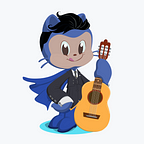My student experience at Stanford ‘Code in Place 2021’
In March 2021, it popped up in my google feed that Stanford Code In Place is happening again this year. I was a bit dejected last year as I had discovered this awesome program just after its applications were closed. But this time, it came up at the right moment. There was time and COVID-19 was still a thing, and I had already realized that this pandemic isn’t going away any sooner.
Application Process
I started my applications with the hope that I’ll get accepted into the program. The application included a section where I was asked about general details, my previous experience with any programming language (although it’s not mandatory), and some short questions about why I wanted to be a part of this program, and what experiences can I bring to the classroom.
The next section included some reading material that was required to complete the exercises as part of the application. I must mention, that the chapters were really easy and anyone with basic logic and reasoning skills can understand and get started with the exercises with absolute ease.
The exercises included 3 questions based on Karel- a robot which lives in a world with four basic instructions namely, move(), turnLeft(), putBeeper(), pickBeeper(). These concepts will lay the foundation of the whole course, so I recommend you to do these exercises at your own pace.
What after Acceptance? (19th April to 28th May)
After getting accepted into the program, we were given access to EdStem to do all our communications with the Code In Place team. In the first week, we had our weekly section allotment with our section leader as per our own preferred day and time. I had my weekly classes on Thursdays at 7:30 pm. Each week we were provided links to lectures, example programs, and assignments. In weekly sections, we discussed some intuitive problems and their approaches with our section leader along with a recap of the week. The most unique aspect of this program is the weekly meetups. They not only help you to collaborate with your classmates but also helps in doubt clearing and keeps you motivated throughout the course.
OhYay (https://ohyay.co/) was the platform where all weekly classes happened live. Here, the virtual spaces are immersive, unlike any other conferencing tool.
There were extra sessions led by volunteers apart from the weekly sessions by section leaders. I really appreciate the time and efforts put forth by them to keep us enthusiastic through their passionate teaching. One of such events was Coding by Campfire by Matt which was really fun.
The complete course was based on the first half of Stanford University’s CS106A course. We were taught Control Flow, Python Expressions, and functions. In addition to that, we had a brief introduction to python's simple image library to work on image processing. Python data structures like lists, tuples, dictionaries working with files comprised were also taught perfectly. This is more than enough to get started with python and build exciting projects too.
Final Projects
At the end of the five-week summer course on python, we were to submit a final project based on our understanding and on any domain using python. Here is the official project showcase of everyone who submitted their projects. https://codeinplace.stanford.edu/2021/showcase
Here’s mine in case you want to see it. 😺https://codeinplace.stanford.edu/2021/showcase/1258
I truly thank my instructors Chris Piech, Mehran Sahami, Julie Zelenski and over 1,100 section leaders who made this possible.
